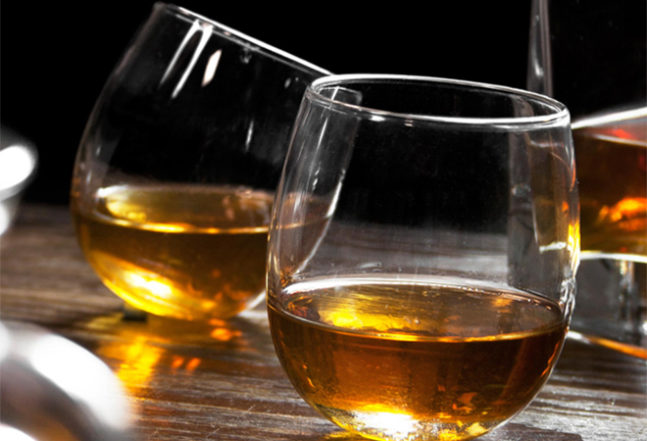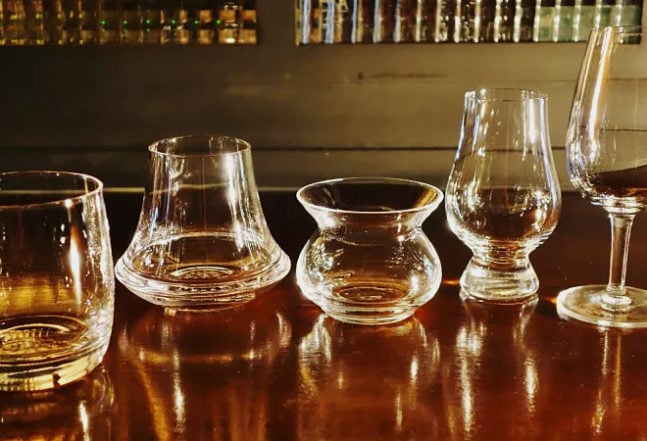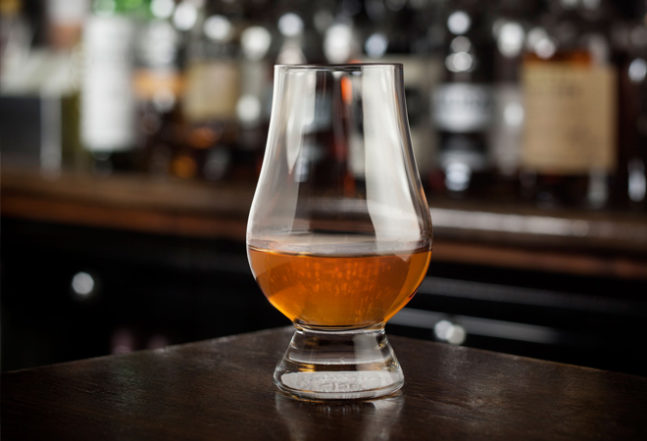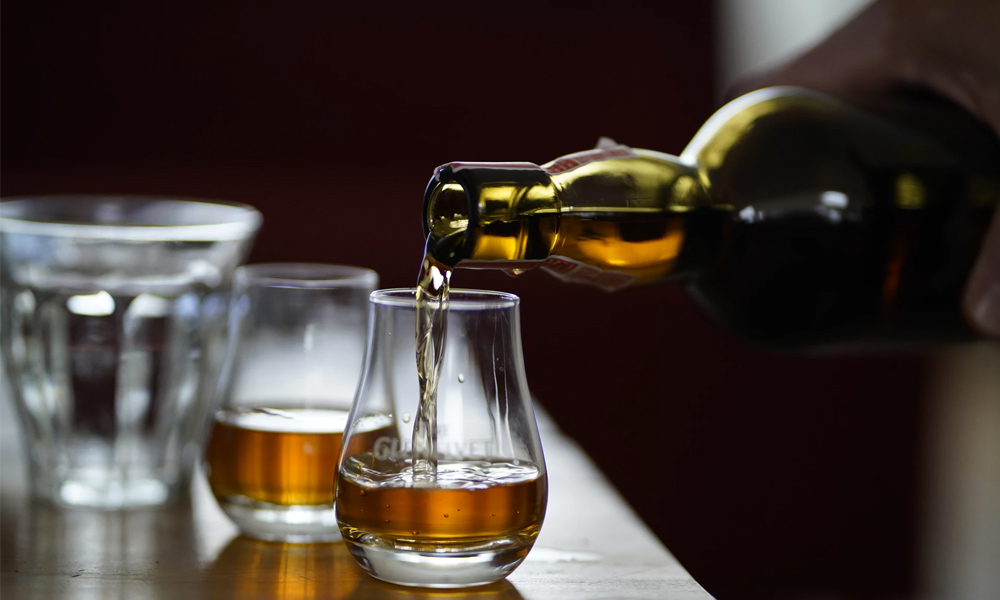(Image – James Hart)
Just because a special shaped glass exists for whiskey drinking doesn’t mean anyone who drinks out of something else is wrong. We’re very much of the Ron Swanson mindset. There’s no wrong way to indulge in your favorite whiskey (unless it comes as some form of freaky handrub). In fact, we spent a long time talking about how the best glass for beer is a glass with beer in it. Broadly, we feel the same way about whiskey.
However, that doesn’t mean we can’t find the origins of the distinctive Glencairn whiskey glass intriguing. It’s become the go-to glass for every whiskey tasting we’ve been to for as long as we’ve been drinking whiskey, and it’s such a weird glass, we can’t help but wonder what the bigger story behind the shape is. So we did some digging. This is the history of the Glencairn whiskey glass.

A Cup of the Water of Life
For most of mankind’s whiskey drinking history people drank from a quaich (sounds like “quake”). The quaich is a drinking bowl with handles on either side and the word comes from the Gaelic word for cup, “cuach.” Like the history of whiskey itself, it has roots in both Ireland and Scotland. Both countries still have native Gaelic speakers and the language itself hasn’t changed much since it came to the British Isles roughly 2,500 years ago. And since whiskey is a Gaelic word too, when a modern person drinks whiskey from a quaich, they’re drinking almost exactly the way someone would have when whiskey was first invented.
Okay, we should be upfront about the fact that no one has a definite date on the invention of the drink. The first written record of whiskey comes from the Lindores Abbey in Scotland in 1494. But, as a knowledgeable Scotsman once told us, the Irish were making whiskey well before that. So let’s agree that whiskey is an old drink, the Irish and the Scottish have equal claim to it, and it’s delicious no matter what kind you prefer. If we agree on all that, we can get back to the drinkware.
Agreeing also allows us to speed up to the quaich in the 16th century. The first quaiches were made of wood and built purely for function, but as they grew as symbols, they began to take on new meaning. By the 1500s, the vessels were used to show off wealth and status as often as they were used to drink. Lower classes stuck with their simple wooden bowls, while the wealthy and powerful commissioned quaiches made of rare or culturally significant wood, precious metals, or both. Eventually, the symbolism around the bowls affected their usage. People grew as loyal to the quaich as modern drinkers are to the current Glencairn glass, to the point where it was used exclusively for whiskey.
As their symbolism grew, Scottish clan leaders used them to show off their own wealth and power, as well as a representation of their hospitality. For them, it was a symbol of good faith and friendship to share a quaich of whiskey with someone. The ceremony of the quaich quickly overtook the practicality of it as a cup and set it on a path similar to that of many traditional drinking vessels. The same way we might currently display beer steins or goblets, the quaich was became something ornamental, not something in general use.
That doesn’t mean it’s disappeared from Scottish culture though. The quaich is still used as a symbolic gift in modern Scotland. Nelson Mandela drank from one as part of his “Freedom of the City” award from Edinburgh in 1997, the Waterloo Tree quaich is said to have been made from the tree under which the Duke of Wellington gave his battle winning orders, and winners in the 2014 Glasgow Commonwealth Games received a quaich along with their medals.
But anywhere in Scotland that’s serious about its whisky isn’t using a wooden bowl to serve it.

The Quaich Tumbles Down
The next milestone in the development of whiskey drinkware was the iconic tumbler. It first appeared in the 17th century, though it didn’t start to overtake the quaich until the 18th, but we’ll get to that. First, some notes on the tumbler itself.
The glass takes its name from the rounded bottom of the early examples. Stories about these first glasses say that if you tried to put the glass down before your drink was finished, the glass would tumble over, spilling its contents. Those claims are dubious and likely exaggerated. There are absolutely drinking vessels that couldn’t stand up straight if put on a table with no support (the drinking horn comes to mind), but common sense dictates a glass that intentionally spilled its contents would experience very little success.
What makes more sense is the claim that the rounded bottoms helped with stability, not hurt it. The bottoms were heavily weighted so when they were knocked or dropped, they quickly returned to an upright position. You’ve undoubtedly seen the principle in action, but if you need living proof, remember Weebles wobble but they don’t fall down. We don’t know the physics behind it, but it certainly looks as if a tumbler made like a Weeble would keep more liquid inside in the case of a spill. They don’t stay on their side. They’ll splash a bit and then pop right back up.
But that’s not the reason the tumbler overtook the quaich, it was just a perk. The real reason was how quickly the price of glass was going down. As more people bought tumblers, their manufacturing got cheaper. As it got cheaper, more people bought tumblers. Continue that cycle a few times and pretty soon tumblers became the most popular glass for whisky consumption and would stay in the top spot for hundreds of years.

One of the Only Good Design Decisions to Come Out of the 1990s
In 1992, a panel of single malt whisky experts were welcomed to the headquarters of Riedel in Austria. They were there to determine if Campbell Distillers’ request for a glass that allows for better exploration of the nuances of single malts was a reasonable one. Two years later, they released their single malt glass and kicked off an era of experimentation in whiskey glassware.
This experimentation grew out of the same belief Campbell Distillers approached Riedel with. The belief that glassware can make a big difference in your experience with whiskey, not to mention just about every other kind of premium alcohol. There haven’t really been definitive findings on the matter, which ties back into our opinion on beer glasses we mentioned in the intro. You can drink whiskey out of pretty much anything and there’s no denying the plethora of choices modern drinkers have for when they want to imbibe. Hell, you can go back to a carved quaich if you want. We won’t bat an eye.
But the industry decided it needed to pick a glass. Which brings us to our 21st century contender.

The Glencairn Finally Arrives
The problem with constant experimentation means it takes a long time for one type to rise to the top of the pile. There’s usually a few decades of in-fighting before anything close to a victor emerges. XKCD covers it pretty well.
Well, it seems we’ve had our decade or so of in-fighting, because the Glencairn glass is quickly becoming the industry default. Its personal story starts sometime in the 1980s (so it actually predates Riedel’s experimentation), when Raymond Davis saw whiskey lacked the official glassware of other spirits. Wine, beer, brandy, and others all had their own distinct glasses, while whiskey was drunk from tumblers, repurposed jelly jars, and anything else you had laying around the house. Davis decided to design his own glass.
For awhile, that’s all that happened with the design. Davis didn’t pursue it all that actively, apparently content to make a prototype and call it there. It wasn’t until his sons found the glass that it went anywhere.
Specifically, it went to the five largest distilleries in Scotland. Their master distillers, who were Robert Mcelroy from Diageo, David Stewart from William Grant & Sons, Robert Hicks from Allied Distillers, Richard Paterson of Whyte & Mackay, and John Ramsey of the Edrington group, worked with Davis’s sons to refine the design. What they ended up with was a slightly more bulbous version of Davis’s original.
In 2001, the Glencairn was officially produced. It was quickly adopted by distilleries, tasting rooms, and whiskey aficionados across Scotland and Ireland and has been spreading ever since. These days, it’s rare to go to a serious whiskey tasting and not be served your dram in the official Glencairn glass. It’s the tumbler of the 21st century and the enthusiasm behind it makes us think this glass has some legs. Expect the next few centuries of whiskey tastings to be dominated by Davis’s design.
And when you inevitably find yourself at a whiskey tasting in the near future, think about how different it’d be if everyone was sipping out of wooden bowls.




